Advertisement
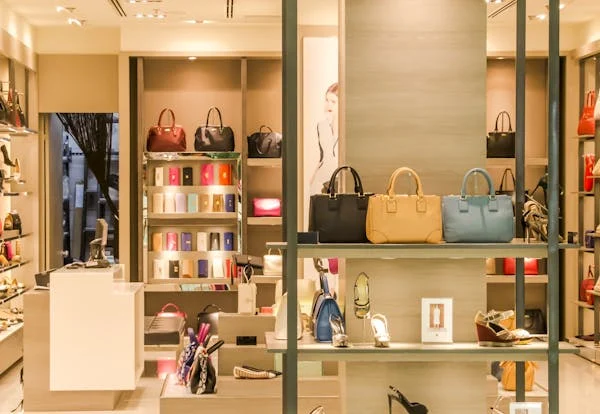
- Updated on May 14, 2025
- IST 10:05 am
“Your ‘Made in India’ saree is 60% Chinese—here’s the proof that’s going viral!”
Imagine this: You’re at a family wedding, twirling in a shimmering Kanjivaram saree, basking in the compliments and that warm glow of supporting Indian artisans. Then, a sneaky peek at the label reveals a shocker—60% of that silk came from China. It’s like biting into a samosa and tasting sushi—unexpected, unsettling, and a bit of a letdown. This isn’t just a wardrobe malfunction; it’s a thread that unravels the clash between India’s “Vocal for Local” pride and a hidden reality. Big brands like FabIndia and Sabyasachi are quietly importing Chinese silk to save a few rupees, while local weavers watch their looms turn into relics. A viral storm on social media—from TikTok dances to Twitter rants—has blown the lid off this secret, and it’s got everyone talking. So, what’s the deal? Let’s dive into this fabric fiasco, chai in hand, and figure out why your saree’s story isn’t as desi as you thought.
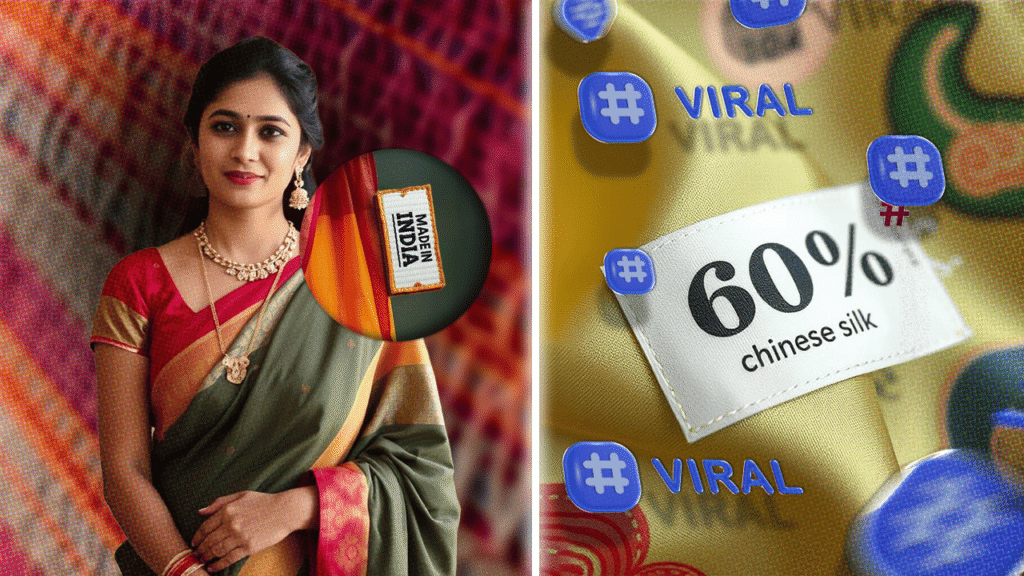
The Viral Spark: A Label That Lit the Internet on Fire
It all kicked off with a single post. Meet Ananya, a 22-year-old from Kolkata who loves her sarees as much as her Instagram aesthetic. She bought a “Made in India” saree from a fancy boutique, only to spot “60% Chinese silk” on the tag. Her reaction? A quick snap, a caption—“Vocal for Local or Vocal for China?”—and boom, the internet exploded. Within hours, #SareeGate was trending, with thousands of likes, retweets, and reels. Teens were filming “saree label checks,” while aunties forwarded WhatsApp messages like detectives on a mission.
Then there’s Vikram, a 38-year-old from Chennai, who shelled out ₹20,000 for a silk saree for his wife, believing it was pure Indian craftsmanship. The label told a different tale, and his fiery tweet—“Paid for desi, got videshi!”—racked up 10K retweets. The numbers don’t lie either: a 2023 Textile Ministry report says 40% of silk in Indian sarees is imported, mostly from China. So, while we’re waving the tricolour, our sarees are singing a global tune—and social media’s making sure we hear it loud and clear.
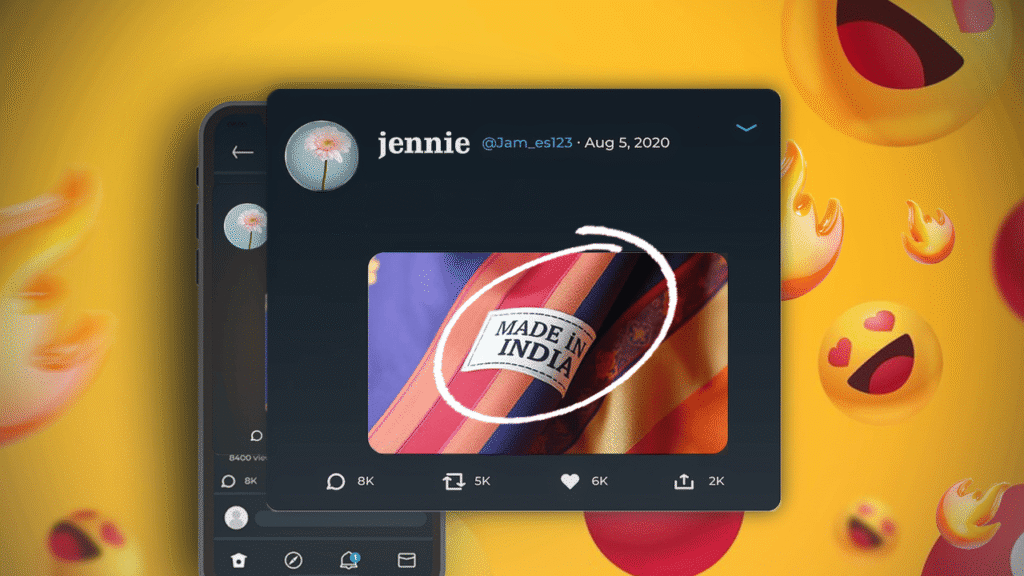
The Silk Switch: Why China’s Winning the Thread Game
Why are brands sneaking in Chinese silk? Simple—money talks. Chinese silk costs up to 30% less than Indian silk, thanks to their massive factories and government subsidies. For companies, it’s like choosing between a ₹50 thali and a ₹35 burger—guess which one they pick? But this bargain comes at a cost. In places like Surat and Varanasi, weavers like Sunita Devi are struggling. “My family’s woven silk for generations,” she says, “but now, orders are drying up.” Her loom sits silent, a dusty reminder of a fading craft.
It’s not just about price—Chinese silk often comes from machines, not hands, missing that desi soul we love. Brands mix it in anyway, betting we won’t notice the difference between a handwoven masterpiece and a factory churn-out. Fashion blogger Meera puts it bluntly: “They’re banking on our ignorance, hiding behind ‘Made in India’ tags.” It’s like serving instant coffee at a traditional filter-kaapi joint—close enough to fool you, but not the real deal.
Government Goals vs. Ground Truth: A Policy Puzzle
The government’s been loud about “Vocal for Local”—PM Modi’s speeches are practically anthems for Indian pride. Schemes like Silk Samagra promise to lift local silk production, but the plot twists faster than a Bollywood drama. Import duties on raw silk hover at a measly 10%, practically rolling out the red carpet for Chinese imports. And enforcement? Let’s just say it’s looser than a dupatta in the wind—labels can be vague, and no one’s checking twice.
Take Priya, a 30-year-old from Hyderabad. She bought a saree touted as “pure Indian silk” for Diwali, only to find it was a sneaky blend. “I trusted the hype,” she sighs. A 2024 Indian Retail Forum survey backs her up—60% of shoppers think “Made in India” means 100% local stuff. Brands aren’t exactly tripping over themselves to clarify, leaving us tangled in a web of good intentions and not-so-great execution.

Social Media’s Revenge: The Power of a Hashtag
Why’s this hitting us so hard? Because sarees aren’t just clothes—they’re culture. They’re the heirlooms we pass down, the stories we wear. Finding out they’re partly Chinese feels like discovering your mom’s secret laddoo recipe uses packaged mix—betrayal with a side of shock. And social media’s turned that shock into a wildfire.
From 15-year-olds making “label reveal” reels to 45-year-olds debating ethics on LinkedIn, the outrage is electric. “It’s about trust,” says Rohan, a 27-year-old from Delhi, whose #BoycottChineseSilk post went viral. WhatsApp groups are buzzing with “Check your saree!” forwards, and Twitter’s a battlefield of opinions. This isn’t just chatter—it’s a wake-up call, with #SupportLocalWeavers trending right alongside the outrage.
Your Saree Survival Kit: How to Shop Smarter
Stuck in this silk mess? Here’s your guide to staying savvy:
- Decode the Label: “Made in India” isn’t enough—hunt for “100% Indian silk” or “handwoven locally.”
- Grill the Seller: Ask where the silk’s from. If they dodge, walk away.
- Go Straight to the Source: Skip the middleman—buy from weavers’ co-ops or sites like iTokri.
- Amplify Your Voice: Snap a pic of dodgy labels and share it online. One post can ripple.
- Push for Truth: Email brands, demand sourcing details. They’ll listen when wallets talk.
This isn’t about banning imports—it’s about knowing what you’re buying. Your choice shapes the game.
The Other Side: Is Chinese Silk Really the Villain?
Let’s flip the pallu for a sec. Chinese silk isn’t the devil—it’s just business. For some brands, blending it in keeps sarees affordable, letting more of us drape that silk vibe. “Without imports, prices would skyrocket,” says textile expert Anjali Rao. Plus, China’s silk game is strong—durable, shiny, and consistent in ways some Indian silks aren’t.
The real problem? The cover-up. If brands said, “Hey, 60% Chinese silk for a better deal,” we could decide for ourselves. Instead, they’re playing hide-and-seek with the truth. As consumer advocate Sanjay puts it, “It’s not the silk—it’s the secrecy.” Love it or hate it, there’s no black-and-white here—just a lot of grey threads to untangle.
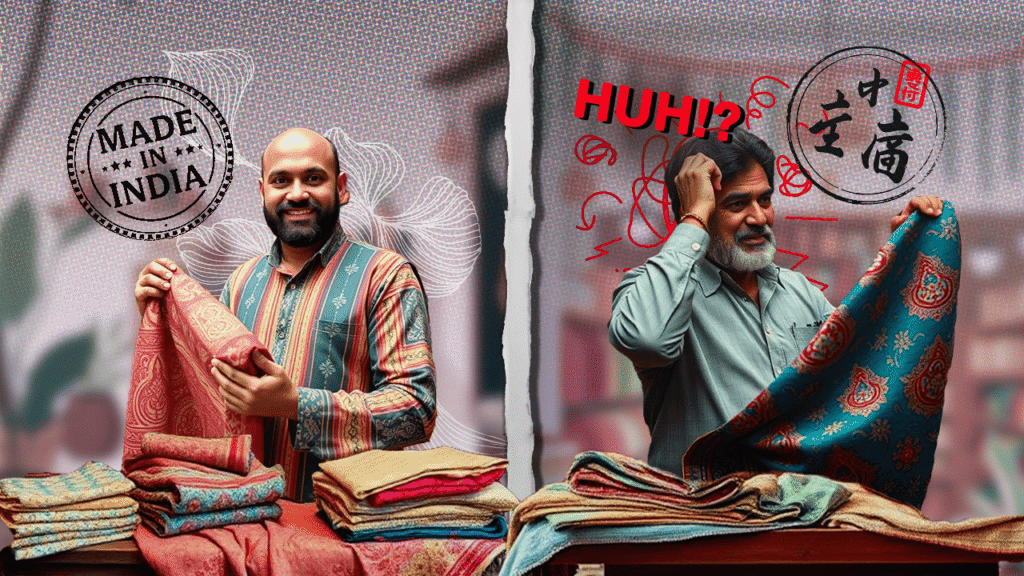
Weaving Tomorrow: What’s Next for Our Sarees?
This viral uproar isn’t fading anytime soon—it’s a chance to rethink everything. The government could tighten labels and boost weavers with real support, not just slogans. Brands could come clean and build trust. And us? We can dig deeper, shop smarter, maybe even take a trip to meet the weavers behind our sarees.
Because a saree’s more than fabric—it’s a legacy. Next time you wear one, peek at the label, share the story, and keep the conversation alive. Your voice could stitch a future where “Made in India” isn’t just a tag—it’s the truth.
You May Like This
Advertisement
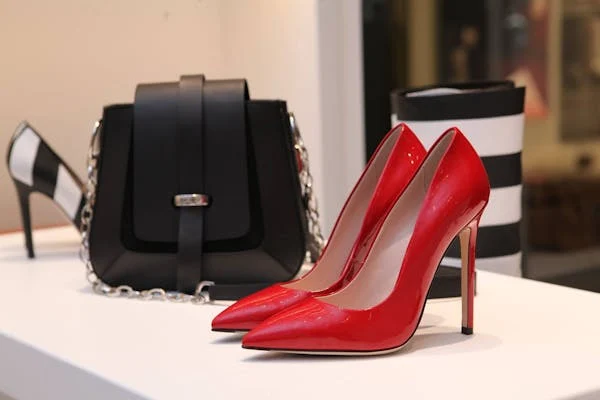
You May Like This








Advertisement
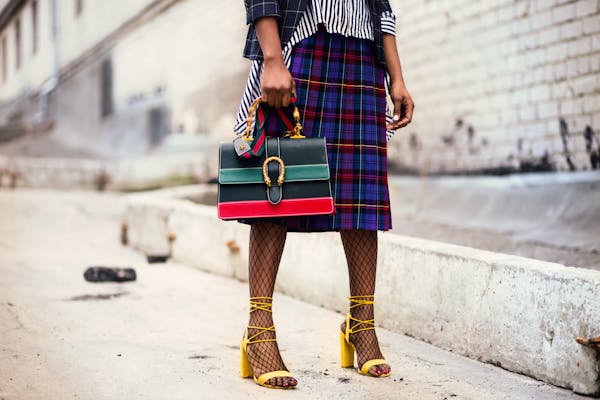
Advertisement

Advertisement


